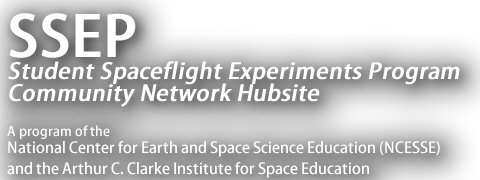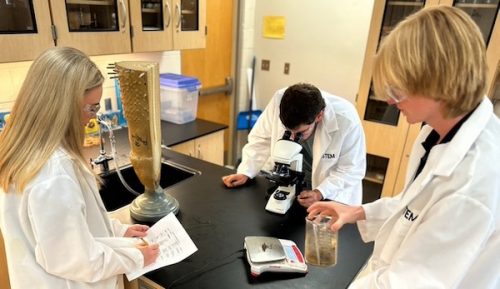The Student Spaceflight Experiments Program is proud to report that there were a total of 41 proposals submitted from student teams across the 4 communities participating in Mission 20 to ISS. Of those, 38 proposals were forwarded for review by Step 1 Review Boards in each of the communities. Each Step 1 Review Board selected up to three finalist proposals, which were submitted to the National SSEP Step 2 Review Board.
On March 31, 2025 the Step 2 Review Board met via Zoom, reviewed the 12 finalist proposals, and selected one proposed experiment to fly for 4 communities, for a total of 4 flight experiments. By April 8, 2025, the National Center for Earth and Space Science Education and the Arthur C. Clarke Institute for Space Education formally notified each community of their selected flight experiments.
It is noteworthy that the 41 proposals received reflected a total of 158 grade 11-16 students fully engaged in experiment design.
All 4 finalist experiment teams, along with descriptions of their proposed flight experiments, are provided below. You are also invited to meet the SSEP Step 2 Review Board members for Mission 20 to ISS.
Congratulations to the over 158 students and their teachers participating in Student Spaceflight Experiments Program Mission 20 to the International Space Station.
Quickly Scroll to Individual Communities
1. Alexander City, Alabama
Jump to Alexander City’s Community Profile
SELECTED FOR FLIGHT:
Investigating the Effects of Microgravity on the Early Root Development Rate of Radishes
Grades 13-14, Central Alabama Community College
Co-Principal Investigators: Allie Scott, Benton Stegall, Noah White
Collaborators: Adlyne Benton, Gracie Deason
Teacher Facilitator: Jeremy Carr
Proposal Summary:
Our experiment aims to study the growth of radish seeds in microgravity and understand how space conditions affect plant development. By investigating changes in growth rates, this experiment will provide valuable insights into how microgravity influences plant biology. The findings are crucial for long-term space missions, where growing food in space is essential for sustainability. This study will also advance our knowledge to help us better understand plant adaptations in space contributing to the development of effective space agriculture strategies. Understanding how plants grow in space will help design better food production systems for astronauts on missions beyond earth and may also offer insights for improving agricultural practices on Earth in resource-limited environments. Our data will come from the root/shoot length and weight and will conclude if life in space under microgravity conditions can be beneficial or if growth is negatively impacted because of the environment.
HONORABLE MENTION FINALISTS:
Discovering the Proliferation and/or Stagnation of HeLa Cells in Microgravity Conditions Compared to Normal Gravitational Forces on Earth
Grades 13-14, Central Alabama Community College
Co-Principal Investigators: Rebekah Burton, Ella Chandler, Kylie Davis, Abigail Hyatt
Teacher Facilitator: Jeremy Carr
Proposal Summary:
HeLa cells, known for their immortality, serve as an ideal model for studying the effects of gravitational distortions on cellular processes like growth and death. Earth’s gravity constantly influences cellular behavior and exploring how these cells behave in microgravity can provide unique insights into cell biology. This experiment will use a controlled microgravity environment to assess if gravity impacts cell proliferation. Other than HeLa cancer cells, no other human samples will be utilized in this experiment. The findings could advance space medicine, cancer research, and cellular biology. While research on cancer and stem cells in microgravity has shown significant changes, no recent studies have focused on HeLa cells in this environment. This gap raises key questions: How do HeLa cells respond to microgravity, and can this research benefit cancer treatment and medicine? HeLa cells, with their rapid growth and long-term viability, are ideal for examining microgravity’s effects. This experiment aims to measure their proliferation or stagnation in space. This study could either confirm prior research or prompt further investigation into space’s impact on cellular behavior. The experiment will offer insights into cellular behavior in space, potentially revolutionizing cancer treatments and medical practices on Earth. Through this experiment, we aim to provide valuable insights into HeLa cell behavior in microgravity, medical advancements, and cancer research. The results of this study may offer groundbreaking revelations that lead to breakthroughs in both space medicine and cellular biology.
Histidine Recrystallization Analysis using IR Spectroscopy
Grades 13-14, Central Alabama Community College
Principal Investigator: Alisa Jordan
Investigators: Dax Culligan, Alese Pike
Collaborators: Anabelle Gordon, Hannah Dean, Julie Ann Wilson
Teacher Facilitator: Jeremy Carr
Proposal Summary:
Several studies have involved the research and analysis of macromolecules through recrystallization in a microgravity environment. These studies take interest in the different physical properties that microgravity-grown crystals have versus that of terrestrial gravity-grown crystals, but do not focus as much on the chemical properties. When two similar forms of matter vary in physical properties, they are also likely to vary in chemical properties. This proposal aims to prepare l-histidine crystals via antisolvent crystallization in terrestrial- and microgravity environments to examine the resulting physical and chemical properties. Each crystal will be analyzed by infrared spectroscopy to compare stretching frequencies between the crystal systems. This will allow observations to be made about the alterations between the functional groups and bond interactions. The team has confidence that the chemical properties of the substance will have endured a change due to microgravity conditions. Looking at a molecule’s chemical properties is important because it helps with identification and classification, observation of reactivity and stability, and ultimately determining how it will react with another substance.
2. Fort Morgan, Colorado
Jump to Fort Morgan’s Community Profile
SELECTED FOR FLIGHT:
Effects of Zero Gravity on The Germination of Radishes in Hydrogel
Grade 14, Morgan Community College
Co-Principal Investigators: McKayla Cranford, Cierra Lebsock
Teacher Facilitators: Bill Miller, Steve Sjostedt
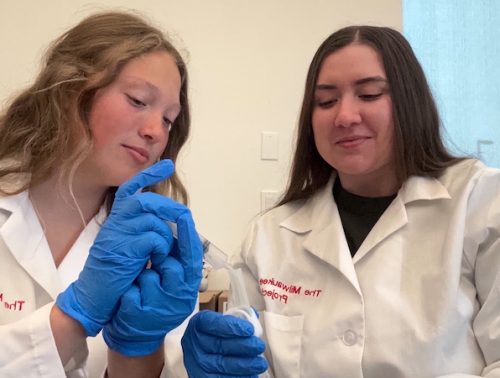
MCC Researchers Cierra Lebsock and McKayla Cranford prepare their mini-lab for planting radish seeds.
Proposal Summary:
The ability to grow plants in microgravity is critical for the sustainability of long-term space missions. This study examines the effects of zero gravity on the germination and early development of radish (Raphanus sativus) seeds grown in a hydrogel medium. Radishes are selected for their fast growth cycle and potential as a space crop. The experiment aims to assess how microgravity influences germination rates, root orientation, and nutrient absorption compared to Earth-based controls. Radish seeds will be embedded in a hydrogel medium within the FME/mini lab. A hydrogel system will ensure consistent hydration without the complications of free-floating liquid. The experiment will be conducted in a microgravity environment aboard the International Space Station (ISS), with identical control experiments carried out on Earth. It is expected that radish seeds will germinate successfully in microgravity but exhibit altered root growth patterns and possibly delayed or inconsistent development. The findings of this research will contribute to understanding how plants adapt to space conditions, providing valuable insights for developing hydroponic and aeroponic cultivation systems in extraterrestrial environments. These results will play a key role in advancing space agriculture and supporting long-term human exploration beyond Earth.
HONORABLE MENTION FINALISTS:
Influence of Gravity on the Efficacy of Bioremediation to Reduce the Presence of Glyphosate
Grades 13-14, Morgan Community College
Co-Principal Investigators: Angela Gomez, Holly Wymore
Teacher Facilitator: Chelsea Crandall
Proposal Summary:
Bioremediation is broadly defined as using living organisms to degrade toxic pollutants. Bioremediation is a favorable alternative to other methods due to its cost and environmental friendliness. However, bioremediation often requires specific conditions be met. The purpose of this research is to investigate how gravity effects the process of bioremediation when using bacteria to degrade a known herbicide. This will likely provide additional understanding of how the bacteria behaves under these specific conditions with the application being relevant to future bioremediation needs in space as well as how bioremediation processes might be improved on Earth.
Effects of Microgravity on Methane Digestion in Methanotrophic Bacteria
Grade 14, Morgan Community College
Co-Principal Investigators: Maria Antonio Gomez, Celeste Eckhard
Teacher Facilitators: Chelsea Crandall, Gavin Fitzgerald
Proposal Summary:
This experiment tests the rate of methane consumption by methanotrophic bacteria in microgravity. The experiment aims to support waste disposal in space. Bacteria could assist waste disposal in microgravity environments. An aerobic methanotrophic bacteria that is active at room temperature will be placed in a chamber of the tube. Methylomonas koyamae is being proposed because of its temperature tolerance and availability. As the Methylomonas koyamae bacteria is exposed to a growth medium a decrease in methane is to be expected. At the end of the experiment glutaraldehyde will be used as a fixative to halt metabolism. When the FME is returned to Earth the amount of methane consumed will be measured.
3. Melbourne, Florida
Jump to Melbourne’s Community Profile
SELECTED FOR FLIGHT:
Hydrogel Radiation-Shielding Viability Under the Influence of Microgravity
Grades 14-16, Florida Institute of Technology
Principal Investigator: Leighton Karpinia
Investigators: Leyla Avant, Sampada Koirala
Collaborators: Emily Matheson, Caroline Moore
Teacher Facilitator: Dr. Andrew Palmer
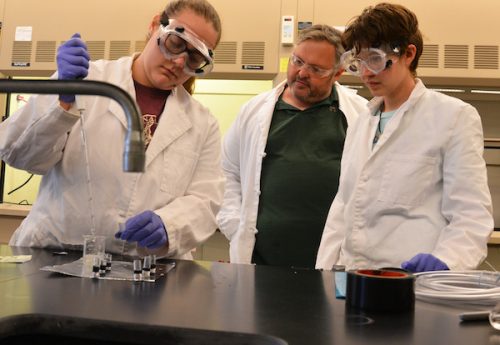
Team members Leighton Karpinia and Caroline Moore optimizing hydrogel production with the supervision of their teacher liaison Andrew Palmer
Proposal Summary:
This proposal aims to study polyvinyl alcohol (PVA) hydrogels’ structural stability and radioprotective properties in microgravity. The study aims to test whether microgravityinduced aggregation affects the integrity of hydrogel networks, which could affect their ability to diffuse radiation effectively. A dehydrated hydrogel sample will be sent to space along with a separate water reservoir. Upon reaching microgravity, the water will be introduced to allow the hydrogel to swell and form its intended structure. Since hydrogels are colloidal suspensions stabilized by hydrogen bonding and polar interactions, microgravity could disrupt these forces, causing polymer aggregation. If aggregation occurs, the hydrogel’s ability to function as an effective radiation shield may be diminished due to uneven polymer distribution. Once the experiment concludes, the samples will be returned to Earth for analysis. Structural integrity will be evaluated through dynamic light scanning, electron microscopy, and mechanical tensile testing. Hydrogels, known for their highly absorbent and flexible 3D polymer networks, have gained interest in biomedical and space applications, including drug delivery, tissue engineering, and radiation shielding. This study will help us understand how the amount of water in a hydrogel and its materials affect its ability to block radiation. The results could lead to better hydrogel materials for protecting astronauts from space radiation and making special dressings that shield patients during cancer treatments.
HONORABLE MENTION FINALISTS:
The Impacts of Microgravity on Ciliary and Flagellar Development
Grade 16, Florida Institute of Technology
Co-Principal Investigators: Lucy Elizabeth Turner, Josh Ahrens, Trevor Mello
Investigator: McKenna Taylor
Teacher Facilitator: Dr. Andrew Palmer
Proposal Summary:
As humanity strives toward long-term space travel and extraterrestrial settlements, it is imperative to understand how microgravity affects the development of cellular structures that play vital roles in individual survival and perpetuation of the species. Cilia and flagella are an example of such cellular structures; the terms cilia and flagella are often used interchangeably and are used as such in this proposal. Cilia are known to be involved in breathing, reproduction, embryonic development, and maintaining the brain. Malfunctioning cilia can lead to defects in these crucial systems. To study the effects of microgravity on ciliary development, this experiment will use the model organism Chlamydomonas reinhardtii. This alga is a unicellular eukaryote with two motile flagella used for swimming. The flagellar development of C. reinhardtii on the International Space Station (ISS) can be used to model the ciliary development of human cells in microgravity. Once the microgravity-grown algae culture returns, the flagella will be observed under the microscope and measured. The length and shape of the developed flagella will be compared to the flagella of C. reinhardtii grown in Earth’s gravity. This comparison will provide valuable insight on how microgravity may affect ciliary development.
Transfer of Ribozymes in Asteroid Halite
Grade 16, Florida Institute of Technology
Principal Investigator: Rahi Kashikar
Investigator: Elizabeth Hayes
Teacher Facilitator: Dr. Andrew Palmer
Proposal Summary:
It has been shown that life can survive inside salt crystals on Earth for long periods of time. The discovery of salts in asteroid samples opens the question on whether important molecules for the origin of life may be protected inside crystals of such salts. This study aims to explore the crystallization of sodium chloride (NaCl) in microgravity and encapsulation of RNA in the form of a hairpin ribozyme in those crystals. Furthermore, we propose to investigate whether RNA may be incorporated inside fluid inclusions in the crystallization process under microgravity. The results will allow us to understand whether salt crystals and fluid inclusions are promising in the context of preservation of critical informational biomolecules in extraterrestrial environments. The suggested experimental setup is simple. On the International Space Station (ISS), dry NaCl and a lyophilized hairpin ribozyme tagged with a fluorescent marker will be mixed with a buffer solution in a single tube to start the crystallization. An identical ground control experiment will be conducted for effective comparison of results. After conducting the experiment on the ISS, post flight analysis will include epifluorescence microscopy, high-resolution mass spectrometry, scanning electron microscopy as well as other methods to observe crystal architecture and the extent of RNA sequestration inside the crystals. This research will advance knowledge of chemical processes that occur on Earth and in space within a wider scope of context reaching the future of astrobiology and materials science.
4. Knoxville, Tennessee
Jump to Knoxville’s Community Profile
SELECTED FOR FLIGHT:
The Effects of Space Travel on Seed Germination and Plant Stress Responses
Grades 15-16, University of Tennessee
Co-Principal Investigators: Nathan Tucker, Devin Vitello
Teacher Facilitator: Dr. Kellie Walters
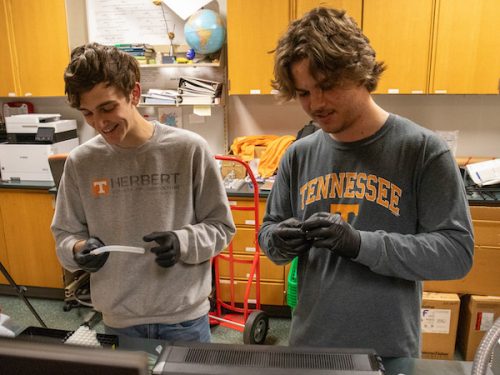
Nathan Tucker (left) and Devin Vitello (right) preparing their mini-laboratory to be filled with seeds at the University of Tennessee Knoxville.
Proposal Summary:
When seeds are exposed to the conditions of space travel, the stress this exerts on them is enough to affect their viability to germinate and health once sprouted. To successfully transport seeds to new planets or on extended space missions, researchers must understand the risks and develop strategies to mitigate potential damage. This project aims to determine if there is a type of seed commonly brought into space that is the least susceptible to the damage caused by space travel. Ten species of seeds, (lettuce, kale, arugula, spinach, broccoli, pac choi, tomatoes, basil, chili peppers, Arabidopsis) will be exposed to simulated radiation and microgravity. There will be two groups of seeds that experience these conditions individually, a group that experiences both, and a control group experiencing neither. After treatment, researchers will germinate seeds and measure their morphological characteristics and germination rate. Seedlings will then be snapfrozen. Half will be measured for reactive oxygen species to determine plant stress, and the rest will be analyzed by SDS-PAGE to determine the change in gene expression. For the second trial, five seed groups will be sent to space on the ISS, and the simulated treatment back on earth will be repeated to better match the conditions and duration of exposure to the ISS trial. This experiment will provide better information about the types of seeds that are best suited for space travel and hopefully identify the seeds that will need extra protection during missions.
HONORABLE MENTION FINALISTS:
Investigating DNA Damage Accumulation and Repair Efficiency in Arabidopsis, Tobacco, and Chamomile Seeds Exposed to Microgravity Conditions
Grades 15-16, University of Tennessee
Co-Principal Investigators: Lily Cooper, Bella Kirchmann
Teacher Facilitator: Dr. Kellie Walters
Proposal Summary:
As humans continue to push the boundaries of space exploration, farming and agriculture in space will be critical for astronaut health and well-being on long-duration missions. Thus, ensuring plant and seed viability in space is a critical factor for sustainable space exploration. However, prolonged exposure to space conditions like microgravity may substantially impair DNA integrity and repair mechanisms, leading to plant genetic instability and threatening longterm food production beyond Earth. Thus, it is critical to understand how microgravity influences DNA damage accumulation and repair efficiency in plants to ensure stable and resilient space crops. This investigation will assess DNA integrity in Arabidopsis, tobacco, and chamomile seeds exposed to microgravity conditions both simulated and aboard the International Space Station (ISS). The study will analyze double-strand break accumulation and the expression of key DNA repair genes upon return to normal gravity conditions on Earth. Furthermore, microgravity-exposed seeds will be tested for germination rates compared to Earth-based control groups. Microgravity-exposed seeds are hypothesized to exhibit increased DNA damage and reduced repair efficiency compared to Earth-based controls and will have lower germination rates. This research will provide key insights into the genomic challenges plants face in space. The findings can also contribute to the development of genetically resilient crops for long duration missions. By identifying plant responses to spaceflight stressors, this study will help advance sustainable space-based agriculture and the success of bioregenerative life support, ensuring a reliable food source for future deep-space exploration and extraterrestrial colonization.
The Fungal Frontier! Investigating Serendipita indica and Rhizophagus intaradices in Space and how Extraterrestrial Environments Affect Synergetic Symbiosis with Ocimum basilicum
Grades 15-16, University of Tennessee
Co-Principal Investigators: Jason Caldwell, Emma Elise Ferber, Jonah Julian
Teacher Facilitator: Dr. Kellie Walters
Proposal Summary:
This experiment investigates the effect of space conditions on two fungi Rhizophagus intraradices (formerly known as Glomus intraradices), Serendipita indica (formerly known as Piriformospora indica), and O. basilicum, Ocimum basilicum ‘Nufar’ seeds. The study aims to identify potential impact extraterrestrial environments have on O. basilicum’s growth, its nutritional value, and potential mutations in the beneficial symbiotic relationship between the two. Fungi help plants with nutrient uptake, nutrient availability, disease resistance, and stress tolerances. O. basilicum is rich in vitamin C, which is one of the most crucial vitamins to astronaut health. Being able to grow plants that can provide essential nutrition to astronauts without having to do additional work beyond picking it off the plant is vital to interstellar travel. This experiment will utilize all three compartments of the mini laboratory, one for each respective fungi and one for O. basilicum seeds. Upon arrival back to Earth we will evaluate the effects of extraterrestrial environments. The space impacted fungi will be inoculated on the space affected O. basilicum in comparison to the same variety of fungi that remained on Earth, and a control plant that is grown with no fungi. As plants continue to grow in space, it is essential to ensure the plants can be grown most efficiently with the highest bioavailability. Since fungi play such a vital role in plant development, learning how fungi respond to extraterrestrial environments is equally as important as learning how to grow plants in space.
